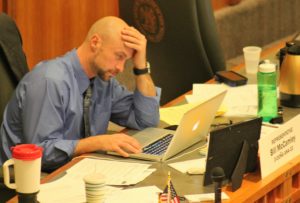PEW Charitable Trusts: NM has highest percentage of 25- to 54-year-olds without jobs.
As New Mexico’s governor and legislative leaders hurl accusations and insults at one another over a state budget and state priorities, the state has reached another low point relating to economic and social conditions: the land of enchantment has highest percentage of 25- to 54-year-olds without jobs.
According to research released on April 13, 2017, by the PEW Charitable Trusts’ States’ Fiscal Health Project (click here for link to report):
“The U.S. employment rate for adults of prime working age rose in 2016, yet remained clearly lower than in 2007, just before the Great Recession. Reflecting the national trend, the percentage of 25- to 54-year-olds with a job was clearly lower in 16 states.”
There are four states that are doing a bit better than just before the 2007-09 recession, and many have seen recovery from that low point – but in New Mexico recovery has been elusive: “for every 100 prime-working-age New Mexicans, 7.2 fewer were employed.”
That is the worst performance by far of any state.
In fairness to members of the political class in New Mexico, they all have been discussing the “jobs” problem.
But the real problem is: that’s about all they are doing … discussing how bad it is – and pointing fingers.
Despite a bit of tweaking here and there, neither the administration nor the legislature has advanced anything significant in their versions of the state budget to turn things around.
This is a serious problem.
Their collective ineffectiveness in addressing job creation accelerates the spiral of economic decline, which in turn negatively impacts both revenue and expenditures of state government.
The Pew report points to this very phenomenon.
“Economic conditions, including employment, are major drivers of state finances. Changes in employment rates among adults in their prime working years can affect both sides of a state’s budget ledger.
Revenue: Paychecks help generate individual income tax dollars and fuel consumer spending, which produces tax revenue from sales and business income.
Expenditures: People without jobs frequently need more services such as Medicaid and other safety-net programs, which can increase states’ costs.”
Course correction requires action – and the weak budgets and lack of new initiatives by government officials come nowhere close to the action needed.
Instead, the state’s politicians on both sides of the political aisle focus on the blame game.
In the meantime, precious time and lives are wasting away … and people in the age groups referred to above (especially younger employables) are walking away from the state.
The one economic development measure both branches did finally agree upon – expanding broadband access (the specifics The Candle will write about in a few days) – is long overdue, and far from complete despite all the self-congratulatory proclamations in the campaign fundraising emails sent out within hours of the end of the regular session.
If you are out of a job, getting out of school and looking for a job, or just plain poor, what both the governor’s and the legislature’s budgets represent are the pits – the absolute pits.
At the end of their regular session, the legislature and the administration had walked away from serious discussion of several measures which could have delivered the defibrillating shock New Mexico’s economy needs.

For example, Representative Bill McCamley (D-Mesilla Park) offered a bill to invest more of the state’s permanent fund in New Mexico “…for distribution for economic stimulus programs over an eight-year period. During the eight-year period, four billion dollars to be provided for infrastructure and energy projects; two billion dollars for research in clean energy and water technologies and technology transfer for such research; and one billion dollars for early childhood services…” as described in the fiscal impact report to the legislature on his proposal.
While it was a big idea, with a big reach, it could have served well as a measure to amend, substitute changes to, or provide whatever legislative maneuver to develop some serious remedial economic change at the state level.
The real downer here was that it died in the Labor and Economic Development Committee – a committee controlled by the Democrats who claimed in the 2016 election cycle: ‘if people put them in charge of the House things will be better.’
McCamley’s idea was killed by one vote – that of his Democratic colleague, Representative Stephanie Garcia Richards (D-Los Alamos), who joined with the Republicans in tabling the measure.
There is still time to change things.
In the next few weeks there is likely to be a special session called by either the governor or the legislature.
If that happens, the public needs to raise its collective voice and tell all of the political leaders to grow up and do something big to pull New Mexico out of its steep economic decline.
Here is how the PEW report describes the significance of “employment-to-population ratio.”
“Although unemployment figures receive substantial media attention, many economists also track the employment-to-population ratio because it provides a broader view of labor market conditions. The unemployment rate, for example, excludes people who are not looking for jobs, but the employment rate captures this group in its measurement of population.
“Focusing on 25- to 54-year-olds reduces the distortion of employment trends resulting from demographic effects such as older and younger workers’ choices regarding retirement or full-time education.”